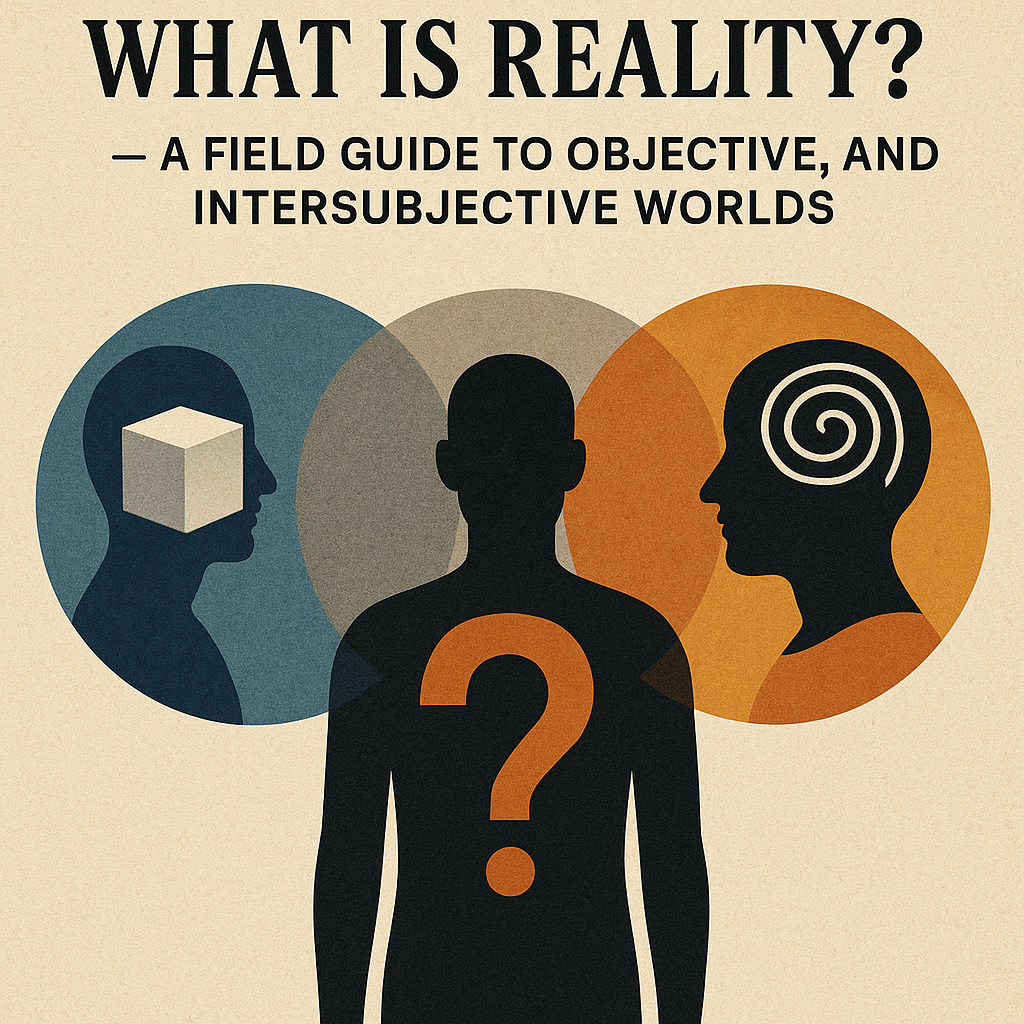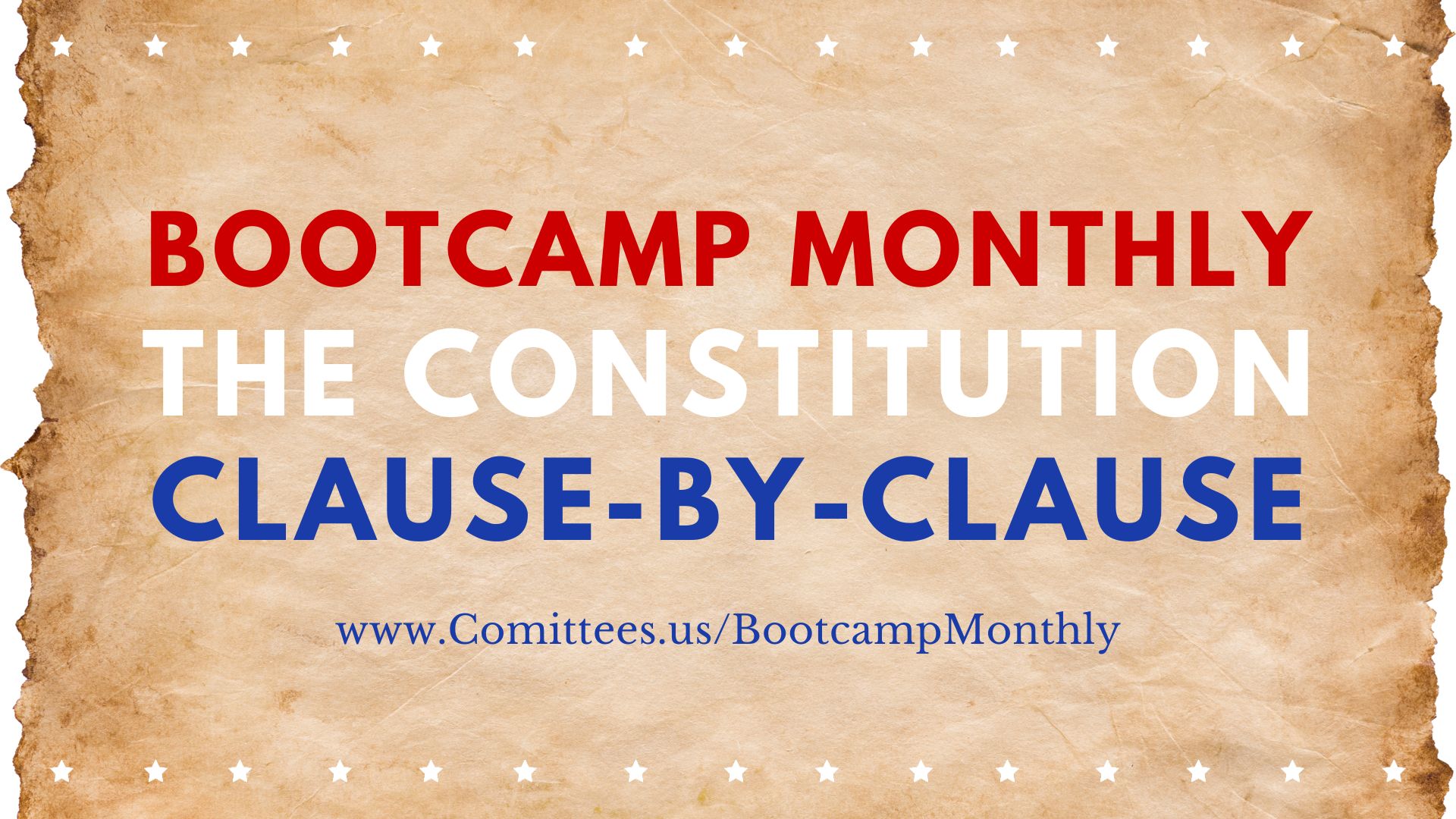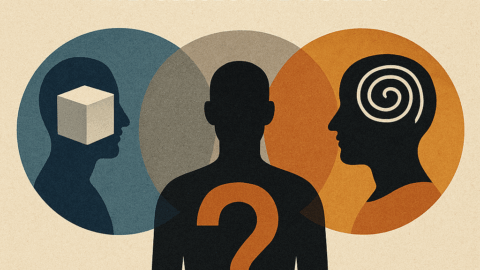“Either you deal with what is the reality, or you can be sure that the reality is going to deal with you.”
—Alex HaleyThat lands because “reality” bumps into us every day—sometimes like a nudge, sometimes like a brick wall. The problem is we often mash different kinds of reality together and talk past each other. Here’s a simple way to keep them straight so you can think clearer, argue less, and make better calls.
The three layers of reality
Objective reality — the world out there (what exists independently of anyone’s beliefs (gravity, viruses, mass, the sun).
What exists whether or not anyone believes it.
- Examples: gravity, viruses, a 20-lb kettlebell, the sun rising, the chemical formula of water.
- Test: If nobody believed this, would it still be true? (Yes → objective.)
Subjective reality — the world in here
Your first-person experience: sensations, pain, taste, memories, emotions, meaning.
- Examples: “This soup is too spicy.” grief after a loss, fear on a tall ladder.
- Test: Is this true-for-me as an experience? Can two people honestly feel differently about it? (Yes → subjective.)
Intersubjective reality — the world between us
Shared “fictions” we create, agree on, and enforce together. They’re not imaginary (they have real consequences), but they only exist because we uphold them.
- Examples: laws, money, borders, brands, job titles, traffic rules, school grades, fashion, norms.
- Test: If everyone stopped believing/enforcing this, would it disappear? (Yes → intersubjective.)
Why the layers matter (and how they mix)
- Seatbelts
- Objective: Physics says sudden deceleration injures bodies.
- Subjective: People don’t want pain; fear and loss are real.
- Intersubjective: We pass seatbelt laws and issue tickets.
The law (intersubjective) is justified by physics (objective) to protect people’s feelings and lives (subjective).- Money
- Intersubjective: Dollars work because we all agree they do.
- Objective: If goods are scarce, prices rise regardless of opinions.
- Subjective: Confidence or panic changes how people spend.
Markets swing when these layers tug in different directions.- Medical advice
- Objective: A drug’s effect measured in trials.
- Subjective: Side effects you feel, your risk tolerance.
- Intersubjective: Guidelines from institutions and insurance rules. Good decisions respect all three: data, your experience, and the rules you have to navigate.” Use laws instead of drug’s
Common mix-ups (avoid these fights)
“My truth” = a subjective experience
- What it is: Your first-person, lived experience—how something felt to you.
- What makes it true: It’s accurate about you (your pain, fear, offense, joy). No one else can tell you you didn’t feel what you felt.
- Good examples:
- “I felt dismissed when you checked your phone while I was talking.”
- “That joke hurt me.”
- “This room feels cold to me.”
- Why it matters: Feelings point to needs (respect, safety, clarity). If we ignore them, problems fester.
“The truth” = an objective claim
- What it is: A statement about the outside world that can be checked against evidence.
- What makes it true: It’s verifiable (timestamps, video, measurements, multiple witnesses, records).
- Good examples:
- “The meeting started at 9:07 a.m. (calendar log).”
- “You said, ‘That was irresponsible,’ at 7:05 p.m. (text/audio).”
- “The speed was 42 mph in a 25 mph zone (radar).”
- Why it matters: Shared facts let us solve problems fairly and repeatably.
Don’t let one erase the other
- Mistake 1 — Feelings as facts: “I felt ignored, so you were ignoring me.” (Maybe; maybe you were distracted by a work alert.)
- Mistake 2 — Facts to dismiss feelings: “I only looked down for 10 seconds, so you shouldn’t feel hurt.” (They still felt hurt.)
Both can be true at once: “You looked at your phone for 10 seconds (objective). I felt dismissed (subjective). Let’s agree on no phones when we’re sharing important stuff (solution).”
Phrases that help (and de-escalate)
- Validate experience: “I believe you felt hurt. I want to understand.”
- Anchor facts: “Here’s what I saw/heard at the time…”
- Bridge to solution: “Given both, what’s a better way next time?”
Watch out for these traps
- Mind-reading: “You meant to embarrass me.” (Switch to facts: what was said/done.)
- Absolutes: “You always/never…” (Name a specific instance instead.)
- Loaded labels: “You’re disrespectful.” (Describe the behavior + impact.)
Bottom line: Honor feelings and check facts. Feelings tell you there’s a problem; facts tell you what happened. You need both to fix it.
- Treating social rules like physics (or vice versa).
“This policy is reality.” No—it’s intersubjective. We can change it together.
“Gravity is just a theory.” No—objective reality doesn’t care how you vote.- Scientism that erases the person.
Lab numbers (objective) aren’t the whole story; pain and fear (subjective) still count.- Nihilism that erases institutions.
“Money is made up, so it doesn’t matter.” It’s made up and enforced—ignore it and rent is still due.A quick playbook for clear thinking
Name the layer before you argue.
“We’re debating an objective claim (what happened), reacting to a subjective experience (how it felt), and deciding an intersubjective policy (what rule we want).”Use the right tools for the layer.
- Objective → evidence, experiments, timestamps, measurements.
- Subjective → listening, empathy, therapy, reflection.
- Intersubjective → negotiation, votes, contracts, culture change.
Translate between layers.
- “The data says X (objective). Here’s how that landed for me (subjective). Given both, I propose we adjust this policy (intersubjective).”
Check for drift with three questions.
- Could the universe keep doing this if no one believed it? (Objective)
- Could two sincere people experience this differently? (Subjective)
- Would this vanish if we stopped agreeing/enforcing it? (Intersubjective)
Living wisely with all three
- Face the brick walls (objective): gravity, deadlines, budgets, biology—plan for them.
- Honor the human (subjective): name feelings, heal wounds, seek meaning.
- Shape the rules (intersubjective): vote, negotiate, rewrite norms that no longer serve the good.
Haley’s warning is simple and generous: deal with reality on all three levels—or it will deal with you. Keep the layers straight, and you’ll make cleaner decisions, have calmer conversations, and build agreements that actually work.
Haley’s warning lands because we collide with reality every day—sometimes gently, sometimes like a brick wall. The catch is that “reality” isn’t just one thing in ordinary conversation. We talk past each other because we mix together three different layers:
Keeping these distinct—and knowing how they interact—prevents confusion and helps us live wisely.
Objective Reality: The World That Pushes Back
Definition: Facts that remain true regardless of opinions or cultures.
Examples
- Physical: water freezes at 0 °C (at 1 atm), pathogens spread, falling objects accelerate near Earth at ~9.8 m/s².
- Biological: insulin regulates blood glucose; organisms evolve by natural selection.
- Constraints: you can disbelieve gravity; you cannot disobey it.
How we know: Measurement, replication, error-correction (science). Objective reality is not “what experts say”; it’s what persists after methods, instruments, and critics take their best shot.
Practical wisdom
- Align plans to constraints (budgets, time, physics).
- Prefer hypotheses that risk being wrong (falsifiable) over ones that can explain anything.
Subjective Reality: The World You Feel From the Inside
Definition: Your private, first-person experience—perceptions, moods, meanings.
Examples
- Pain is real even when no tissue damage is found; joy is real even when no scanner “lights up happiness.”
- Two people at the same concert have different experiences—both true for them.
How we honor it
- Empathic listening, trauma-informed care, respect for conscience, attention to mental models and biases.
Practical wisdom
- Treat feelings as data, not dictators.
- Calibrate: “I feel unsafe” (subjective) may or may not mean “I am in danger” (objective).
Intersubjective Reality: The Worlds We Make Together
Definition: Shared systems that become real because many people believe and act as if they are real.
Also called: “Social realities” or, in philosopher John Searle’s terms, institutional facts (e.g., “This paper counts as money,” “This person has authority,” “This line is a border”).
Examples
- Money, markets, laws, courts, corporations, countries, religions, calendars, academic credentials, traffic rules, brand reputations, online platforms.
Properties
- They aren’t illusions; they’re collective agreements with teeth (laws can jail you; markets can bankrupt you).
- They ride on objective substrates (paper, servers, guns, roads) and shape subjective lives (status, shame, pride).
Practical wisdom
- You can change intersubjective reality (laws, policies, norms) through persuasion, coalitions, and institutions—but not by ignoring objective constraints or gaslighting others’ subjective experience.
How the Three Layers Interact
- Objective ⟶ Intersubjective: A pandemic (objective) triggers public-health rules and market shocks (intersubjective).
- Intersubjective ⟶ Subjective: A job loss (intersubjective status change) can produce grief and anxiety (subjective).
- Subjective ⟶ Objective: Beliefs influence behavior; behavior changes bodies and environments (placebo/nocebo, training effects, pollution).
Category mistakes to avoid
- Turning preferences into facts: “This music is bad” (subjective) ≠ “This note is out of tune” (objective).
- Treating social rules as laws of nature: “The market must go up” (intersubjective) ≠ conservation of energy (objective).
- Dismissing lived experience: “Data says you shouldn’t be sad” confuses third-person stats with first-person reality.
Three Theories of “Truth” (Quick Compass)
- Correspondence (objective): A statement is true if it matches the world (“There is ice on the road”).
- Coherence (intersubjective): A claim fits with a larger web of beliefs and rules (case law, math axioms).
- Pragmatic (mixed): “True enough to work” for a purpose (engineering tolerances, medical protocols).
Mature thinkers shuttle among all three—without letting one colonize the others.
Reality in the Wild: Common Debates Reframed
- Free speech vs. harm:
- Objective: certain speech correlates with measurable harms in some contexts.
- Subjective: people’s pain/insult thresholds vary.
- Intersubjective: societies set speech rules (laws, platform policies).
Wise stance: protect wide speech by default; narrowly tailor limits using objective evidence of harm, with due process (intersubjective), while hearing those affected (subjective).
- Money & finance:
- Objective: scarcity, energy, time.
- Intersubjective: fiat currency, credit, ratings.
Wise stance: don’t mistake policy narratives for natural laws; manage risk to what physics and math will allow.
- Health & nutrition:
- Objective: randomized trials, biomarkers.
- Subjective: bodies differ in response and tolerance.
- Intersubjective: guidelines, insurance coverage.
Wise stance: start with evidence; personalize with experience; navigate systems to access care.
A Practical Toolkit for Dealing With Reality (Before It Deals With You)
For objective reality
- Ask, “What would prove me wrong?” (falsify).
- Look for base rates, controls, replications.
- Prefer measurements over vibes.
For subjective reality
- Name your state: “I’m anxious; it makes me overestimate threats.”
- Use cognitive hygiene: track triggers, sleep, nutrition, movement.
- Seek wise others for perspective.
For intersubjective reality
- Map the rules: who decides, by what process?
- Change the game: build coalitions, write proposals, vote, litigate, innovate.
- Guard against manipulation: recognize propaganda, bots, and perverse incentives.
Bridge practices (all three)
- Steelman: restate an opponent’s view better than they did.
- Epistemic humility: hold strong opinions loosely; update with new evidence.
- Time horizons: ask what’s true in 10 minutes, 10 months, 10 years.
Why This Distinction Heals Conversations
Most “culture war” fights are category fights:
- One side is arguing subjective harm; the other demands objective proof.
- One side cites intersubjective rules; the other points to objective limits.
- Both sides think the other is “denying reality,” but they mean different layers.
Naming the layer (“I’m describing objective risk,” “I’m sharing my subjective pain,” “I’m proposing an intersubjective rule”) reduces heat and increases light.
A One-Page Summary You Can Share
- Objective reality: mind-independent facts. Method: measure, test, replicate.
- Subjective reality: first-person experience. Method: listen, reflect, regulate.
- Intersubjective reality: shared institutions and meanings. Method: deliberate, legislate, codify.
Wisdom:
- Anchor to the objective.
- Honor the subjective.
- Steward the intersubjective.
Or as Haley might put it: Face the world as it is, care for people as they are, and shape the world we share—before it shapes us.






